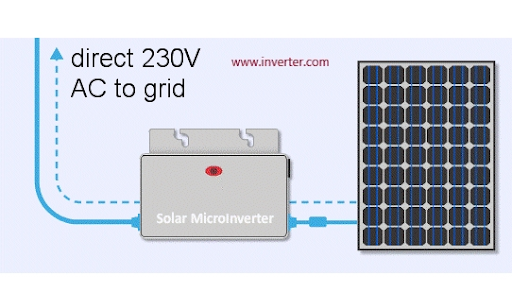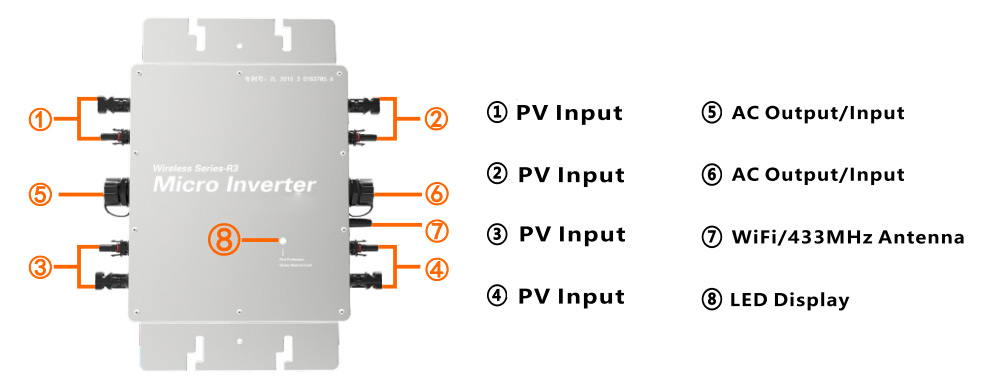Learn how a microinverter ensures your solar system operates smoothly and safely in this post.
The use of solar energy is becoming increasingly popular in both households and offices due to its ability to reduce electricity bills and provide clean, reliable power. The micro inverter is the most significant component of maintaining a solar system, which is functioning and safe.
A micro inverter is used to convert the DC power of each solar panel into AC power so that your lights, fans and appliances could operate correctly. It regulates the work of individual panels and this makes the whole system more stable, safe and efficient.
That is why it is necessary to learn the working principle of a micro inverter in the first place. When you understand the mechanism of operation well, you will be in a better position to make an informed decision on which microinverter is best suited to your solar system.
Table of Contents
What Is a Microinverter?
A microinverter is a small device that is installed on each panel of the sun. A microinverter will be used to power just one panel, converting the DC electricity to AC electricity, unlike a large inverter that powers all the panels simultaneously.
How a Micro Inverter Improves Safety and Performance
1. Greater safety using panel-level conversion.
Micro inverters transform DC directly in each solar panel to AC power; this has the following safety advantages:
- Reduces the quantity of high-voltage DC in the system.
- Minimizes the risks of electrical faults, arc flash, and fire hazards.
- Makes rooftop and residential user and installer friendly.
This is one of the primary reasons why microinverters are widely used in households, small businesses, and rooftop PV systems.
2. Independent Panel Control
The system has:
- Panel-level optimization
- Good results regardless of whether one of the panels is stained or dirty.
- No total power drop of a single weak panel.
This is maximization of total energy production in the day.
3. Quick Adaptation to Changes in the Sunlight.
Micro inverters have a highly developed electronic technology which responds immediately to:
- Sudden changes in sunlight
- Partial shading
- Weather variations
This rapid response also guarantees more stable and reliable output than the conventional string inverters.
4. Improved surveillance and Reliability in the Long-term.
Micro inverters permit per-unit monitoring, which permits:
- The performance of every panel can be easily tracked.
- Early detection of issues
- Better system service.
- A solar system with a low-cost, prolonged implementation.
How does a Micro Inverter work?
A solar panel is a micro inverter, which converts the DC power to the AC power and an in-built circuit is built by the micro inverter. The inverter continuously measures the quantity of sunlight that the panel is capturing and adjusts its output to the optimum output.
It does this by:
- The measurement of voltage and current of the panel.
- Location of best working point (MPPT Maximum Power Point Tracking) location.
- Transform the power to AC that is identical to the one in your house.
- Wiring of the AC power to the main panel in a safe manner.
This smart algorithm happens every one second hence the reason why micro inverters will produce similar power in the event of the sunlight fluctuation.
READ ALSO: How To Keep Your Business Running Smoothly
Step-by-Step Guide to Installing a Micro Inverter
To ensure a microinverter is accurate and safe, follow the steps below. These measures include installation and running processes to ensure a clear and comprehensive understanding.
The Micro Inverter will be installed under the solar panel as the first step.
The best microinverters are designed to be mounted or fixed directly under the panel.
Attach it to the mounting rail, not to come into direct contact with water.
Make the label readable to ensure it can be easily checked in the future.
This provides the machine with sufficient airflow and a longer lifespan.
Step 2: DC Cables of Solar panel interlinking
Solar panels contain negative and positive connectors.
Install them on the micro inverter DC input.
The microinverters currently available have locks to prevent loose contact.
This is aimed at preparing the panel that is used in converting energy.
Step 3: Connect the AC Trunk Cable using the Micro Inverter
The use of micro inverters involves working on AC and hence has to be connected to a trunk cable that takes power in multiple inverters.
Ensure that:
- The connector is tight
- The cable can be used in outdoor environments.
- Waterproof seals are intact
This is achieved to sustain the production of AC by the entire array of AC at all times.
Step 4: identification of the grid and transformation into power
Once the system has been wired, the micro inverter will automatically:
- Detect the grid
- Match the frequency
- Begin converting DC to AC
Only at grid detection, Inverter Activation. This eliminates the chances of the power flowing against a line and renders the system safe.
Step 5: Track the Results in the Monitors App
New micro inverters are either wireless or monitor wirelessly.
The app will show:
- Power output of each panel
- Voltage levels
- Energy history
- The alerts regarding non-performance of a panel.
Check cable connections or shading issues, in the event of unreliable readings.
Step 6: Safety Precautions towards Reliable Operation
To service your micro inverter:
- Close proximity to standing water should not be used for installation.
- One should not put heavy things on cables.
- Do not insert chipped wiring in the inverter.
- Make sure that the grounding is correct.
- Switch the system off, and then repair it.
A micro inverter works safely and effectively in any solar system provided it is well taken care of.
Why Rely on a Micro Inverter?
The inverter used is a micro inverter which guarantees high performance, high level of safety and ease of maintenance of power generation using solar power. It is these reasons that make this device unique.
Improved Power Output
- All the panels are autonomous.
- The performance of one of the shades of the panel does not decrease the performance of other shades.
- This gives enhanced and highlighted energy production.
Higher Safety Standards
- In the panel, micro inverters transform DC to AC.
- This reduces the high-voltage DC lines of the roof.
- This is what ensures the security of the user and the property during operation and maintenance.
Flexible System Design
Inasmuch as the panel is inverted individually:
- Panels can be added anytime
- Non-parallel roofs are well rounded.
- One can assume that the replacement of one unit leaves the rest unchanged.
This flexibility makes microinverters ideal for homes and upgraded systems.
Advanced Monitoring
Micro inverters allow panel level monitoring.
Performance of each panel could be observed individually.
This helps with:
- Faster fault detection
- Preventive maintenance
- Better energy planning
Applications Micro Inverter
The micro inverters can be used in various solar power conditions:
- Home Rooftops: To win and ensure power.
- Business premises: Good surveillance.
- Solar Carports: This can be used in the shady areas.
- Hybrid Systems: Battery systems are suitable.
- Small Businesses: Unchallenging expansion opportunities.
Micro Inverter vs. String Inverter: What’s the Difference?
We should have a look at the table before considering the two types of inverters:
- Micro Inverter: Each solar panel comes with a converter that converts DC to AC at the panel level. It enables each panel to operate independently thereby enhancing safety, performance and monitoring.
- String Inverter: This is an inverter that has a collection of panels attached to it (called a string) and converts the DC power from a group of panels into AC power. The weakest panel of the string determines performance.
| Feature | Micro Inverter | String Inverter |
| Power Production | Panel-level | Group-level |
| Safety | High | Moderate |
| Shade Handling | Excellent | Weak |
| Monitoring | Detailed | Basic |
| Expansion | Easy | Limited |
Summary:
Micro inverters provide superior safety, better handling of shading, detailed per-panel monitoring, and easier expansion. While string inverters can be more cost-effective for larger systems, micro inverters deliver higher efficiency and reliability, especially in residential or small-scale solar setups.
Micro Inverter Care and Maintenance
To make sure that your micro inverter will have a years life:
- Keep it clean and dry
- Perform periodic scrutinies of checks.
- Remove shade from panels
- Update monitoring software
- Provide sufficient ventilation under paneling.
Looking after will ensure long life expectancy and excellent work.
Future Micro inverter solar technology
Micro inverters are becoming intelligent with:
- Bluetooth and Wi-Fi
- Data logging
- Rapid shutdown technology
- Greater efficiency of conversion.
These enhancements make the management of solar power easier and safer by the users.
Conclusion
The microinverter is an intelligent, flexible, and extremely safe solar system that suits any home or business. The panels operate independently, thereby maximizing energy production, ensuring system safety, and facilitating easy monitoring.
Learn about our solar system, compare solar inverters, and discover how an appropriate microinverter can be used to increase your energy efficiency, minimize risks, and enable you to use clean power to power your home and business in the coming years.
Don’t install solar, make smarter, safer, and more powerful solar with microinverters!
INTERESTING POSTS
- Best Antivirus For 2022
- Is Voltage Stabilizer Required For Inverter AC?
- Full Trend Micro Maximum Security Review
- Navigating the Nexus: Cybersecurity’s Role in the World of Residential Solar Technologies
- Projecting Future Solar Energy Requirements: A Journey into Sustainable Power
- How Gas Detectors Improve Safety and Protection in Homes and Workplaces
About the Author:
Mikkelsen Holm is an M.Sc. Cybersecurity graduate with over six years of experience in writing cybersecurity news, reviews, and tutorials. He is passionate about helping individuals and organizations protect their digital assets, and is a regular contributor to various cybersecurity publications. He is an advocate for the adoption of best practices in the field of cybersecurity and has a deep understanding of the industry.









